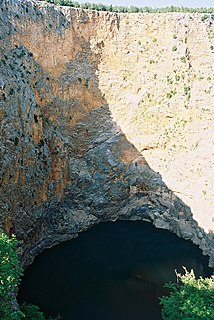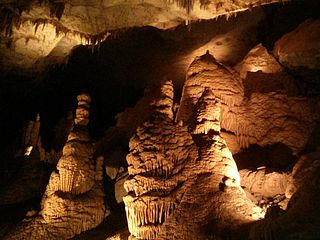
Gypsum is a soft sulfate mineral composed of calcium sulfate dihydrate, with the chemical formula CaSO4·2H2O. It is widely mined and is used as a fertilizer and as the main constituent in many forms of plaster, blackboard/sidewalk chalk, and drywall. A massive fine-grained white or lightly tinted variety of gypsum, called alabaster, has been used for sculpture by many cultures including Ancient Egypt, Mesopotamia, Ancient Rome, the Byzantine Empire, and the Nottingham alabasters of Medieval England. Gypsum also crystallizes as translucent crystals of selenite. It also forms as an evaporite mineral and as a hydration product of anhydrite.

Karst is a topography formed from the dissolution of soluble rocks such as limestone, dolomite, and gypsum. It is characterized by underground drainage systems with sinkholes and caves. It has also been documented for more weathering-resistant rocks, such as quartzite, given the right conditions. Subterranean drainage may limit surface water, with few to no rivers or lakes. However, in regions where the dissolved bedrock is covered or confined by one or more superimposed non-soluble rock strata, distinctive karst features may occur only at subsurface levels and can be totally missing above ground.

A sinkhole, also known as a cenote, sink, sink-hole, swallet, swallow hole, or doline, is a depression or hole in the ground caused by some form of collapse of the surface layer. Most are caused by karst processes – the chemical dissolution of carbonate rocks or suffosion processes. Sinkholes vary in size from 1 to 600 m both in diameter and depth, and vary in form from soil-lined bowls to bedrock-edged chasms. Sinkholes may form gradually or suddenly, and are found worldwide.

Travertine is a form of limestone deposited by mineral springs, especially hot springs. Travertine often has a fibrous or concentric appearance and exists in white, tan, cream-colored, and even rusty varieties. It is formed by a process of rapid precipitation of calcium carbonate, often at the mouth of a hot spring or in a limestone cave. In the latter, it can form stalactites, stalagmites, and other speleothems. It is frequently used in Italy and elsewhere as a building material.

Geodes are geological secondary formations within sedimentary and volcanic rocks. Geodes are hollow, vaguely spherical rocks, in which masses of mineral matter are secluded. The crystals are formed by the filling of vesicles in volcanic and sub-volcanic rocks by minerals deposited from hydrothermal fluids; or by the dissolution of syn-genetic concretions and partial filling by the same, or other, minerals precipitated from water, groundwater or hydrothermal fluids.

Selenite, also known as satin spar, desert rose, or gypsum flower are four crystal structure varieties of the mineral gypsum. These four varieties of gypsum may be grouped together and called selenite.

The Naica Mine of the Mexican state of Chihuahua, is a lead, zinc and silver mine that also contains extremely large selenite crystals. Located in Naica in the municipality of Saucillo, the Naica Mine is owned by Industrias Peñoles, the world's largest silver producer. Caverns discovered during mining operations contain crystals of selenite (gypsum) as large as 1.2 m (4 ft) in diameter and 15 m (50 ft) long. Peñoles announced in October 2015 that it was indefinitely suspending operations due to uncontrollable flooding at the Naica Mine.

Anthodites (Greek ἄνθος ánthos, "flower", -ode, adjectival combining form, -ite adjectival suffix) are speleothems (cave formations) composed of long needle-like crystals situated in clusters which radiate outward from a common base. The "needles" may be quill-like or feathery. Most anthodites are made of the mineral aragonite (a variety of calcium carbonate, CaCO3), although some are composed of gypsum (CaSO4·2H2O).

Optymistychna is a gypsum cave located near the Ukrainian village of Korolivka, Borshchiv Raion, Ternopil Oblast. Approximately 230 km (140 mi) of passageways have been mapped within. As a result, it is the longest cave in Eurasia and the fifth-longest cave in the world, after Mammoth Cave, Sistema Sac Actun, Jewel Cave and Sistema Ox Bel Ha. It is also the longest gypsum cave in the world.

Cumberland Caverns is a national natural landmark and show cave located in McMinnville. It is the second longest cave in Tennessee and makes the list of longest caves in the United States and in the world.

Cave of the Crystals or Giant Crystal Cave is a cave connected to the Naica Mine at a depth of 300 metres (980 ft), in Naica, Chihuahua, Mexico.

A solutional cave or karst cave is a cave usually formed in the soluble rock limestone. It is the most frequently occurring type of cave. It can also form in other rocks, including chalk, dolomite, marble, salt beds, and gypsum.

Fengshan County is a county of Guangxi, China. It is under the administration of Hechi City.

Furong Cave is a karst cave located on the banks of the Furong River, 20 km (12 mi) from the seat of Wulong District, Chongqing, People's Republic of China.

Gruta de Maquiné (MG-0243), also Lapa Nova de Maquiné, is the oldest and one of the most commercially visited caves in Brazil. It is located about 5 km (3.1 mi) from Cordisburgo and 143 km (88.9 mi) northwest of Belo Horizonte, in the State of Minas Gerais. The cave has seven huge chambers explored, amounting to 650 m (2,130 ft) (linear) and unevenness of the ground of only 18 m (59 ft). Safety measures like lighting, walkways and handrails allow a multitude of visitors to enjoy safely the wonders of the grotto where the whole journey is accompanied by an experienced local guide.

The Cliefden Caves ia heritage-listed geoheritage site in Mandurama, Cowra Shire, New South Wales, Australia. The caves comprises Ordovician fossil localities, limestone caves, a spring and tufa dams, and a site where limestone was first discovered in inland Australia.

Atlantida is a karst cave in Ukraine, most famous for its unusual geology, rare formations, and pristine condition. It is located at the bank of the river Zbruch in Kamianets-Podilskyi Raion of the Khmelnytskyi Oblast, close to Zavallya village. The cave is 2525 m long and 18 m deep, with 4440 m² area. Subordinated to the Tourism and Excursions Council of Khmelnytskyi Oblast, the cave is a part of the Podilski Tovtry National Nature Park.
A gypsum cave is a natural karstic formation in gypsum. Gypsum karst is very rare. It depends on deposits of gypsum or anhydrite, often also called alabaster. Chemically it is calcium sulfate, CaSO4.

Jebel Nakhsh is a mountain ridge in southern Qatar that stands roughly 90 meters (300 ft) tall and which runs southeast-to-northwest for 33 km side by side with the western coast. Three main rock layers make up the mountain, the bottom layer containing multiple burrows and being primarily composed of limestone, marl, and shale, the middle layer, which is also the largest, being made up of limestone, marl, stromatolitic limestone and evaporites, and the top layer comprising mainly limestone.

















